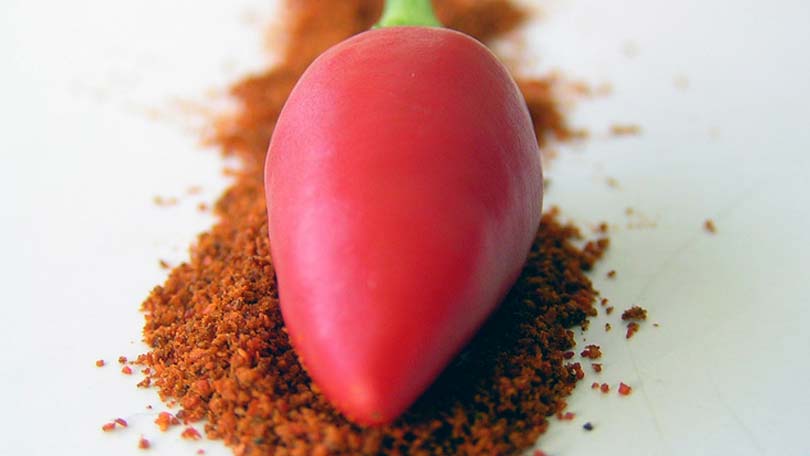
Chili powder, made from the roasted and/or dried fruit of dozens of species in the Capsicum grouping, is a potent dust useful to many world cuisines. While chilies are native to South America, it is difficult to classify the peppers or the resulting powder under one native region – chilies are the most widely grown spice in the world, and have infiltrated countless kitchens across the globe.
Characteristics
Chilies are the fruits of a class of small, sometimes woody shrubs which tend to prefer warm growing conditions. Though the structure can differ slightly depending on variety, the basic make-up of the fruit is the same: a deep hued skin covering a layer of moist flesh, which surrounds a pith-like tissue and seeds at the center. Chilies get their heat from the powerful chemical capsaicin, which protects the seeds from animals. This defense tends only to effect mammals as the pith, flesh, and stems must be ruptured by chewing to release their chemical attack – birds or creatures which do not chew will not be as affected by this potent security system.
Capsaicin, for several natural reasons, is more concentrated and strong in fruits which grow in high temperatures. Growing conditions, genetic make-up, plant care, and environment can all effect the potency of the plant, so be careful – not all chilies are created equal.
Chili powder is generally very pungent, with plenty of heat in the mouth and nostrils.
Common Uses
There are two types of chili based powders used in the culinary world. chili powder is simply dried ground chili peppers, and is added to spicy dishes and spice blends in Thai, Indian, Asian, Mexican, Spanish, South American, and American cuisines.
Its close relative, chili powder, is a blend of several ingredients which often include chili powder. Chili powder is used primarily in American and Mexican cuisines, and is generally a blend of several ground chili varieties, cumin, and other spices such as garlic powder, oregano, paprika, or cinnamon; chili varieties used might include ancho, cayenne, chipotle, etc., with the goal being a balance between spicy heat and peppery flavor. The ingredients then are roasted or dry cooked in a hot skillet, then ground into a fine powder.
Chili powder is used most commonly to flavor – as it should be – chili con carne. The blend was likely originated by Indian cooks, who have a history of skill with potent ground spice blends.
Use and Storage
Chili and chili powders can be found in most supermarkets, grocery, and specialty stores. The powder is keeps well when stored in an airtight container out of direct sunlight.
Use It (How to/where)
- in spice blends for Indian, Asian, and Thai cuisines
- to add a kick to BBQ sauce
- to heat up salsas or spicy chutney
- in bean dishes
- to season rice
- in stews or Tex-Mex chowders
- in soups (particularly tomato or roasted pepper)
- in lentil dishes
- as part of spice rubs for meat
- to season ground meat for tacos, enchiladas, and other Mexican fare
Recipe using Chili Powder
Traditional Chili Powder
3 ancho chiles
3 dried arbo chiles
3 chipotle peppers
1 pasilla chili
2 ¼ tbsp. garlic
2 ¼ tbsp. cumin seed
1 ¼ tbsp. oregano
1 heaping teaspoon paprika
Pinch ground cinnamon
Place all chilies and cumin seed in a pan or cast iron skillet over medium high heat. Heat until fragrant, about five minutes, stirring constantly to prevent burning. Set pan aside to cool. When cooled, pour blend and dried spices into food processor churn to a fine powder. Store powder in an airtight container out of direct sunlight.
